Potensic produce drones that range in size and price depending upon your age and experience. Everything from the small and inexpensive mini drones for kids, the mid-priced drones to the more expensive, feature-packed options for more experienced flyers, Potensic has a drone that’s suited to your needs, your experience and your budget.
The Potensic D80 (which you can buy here) is designed for those who maybe have a little experience under their belt and are looking for a drone that can deliver the goods in terms of performance but without dropping the ball on price. Will it give you more bang for your buck in the air or simply a bang as it hits the ground?
Our Score for the Potensic D80 Drone
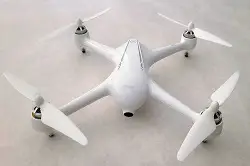 Learn More |
Overall Expert Rating What we like: |
|---|---|
| Getting Started | |
| Batteries | |
| Features | |
| Ease of Use | |
| Value for Money |
All Photos Credit: Richard J. Bartlett
About the Potensic D80 Drone
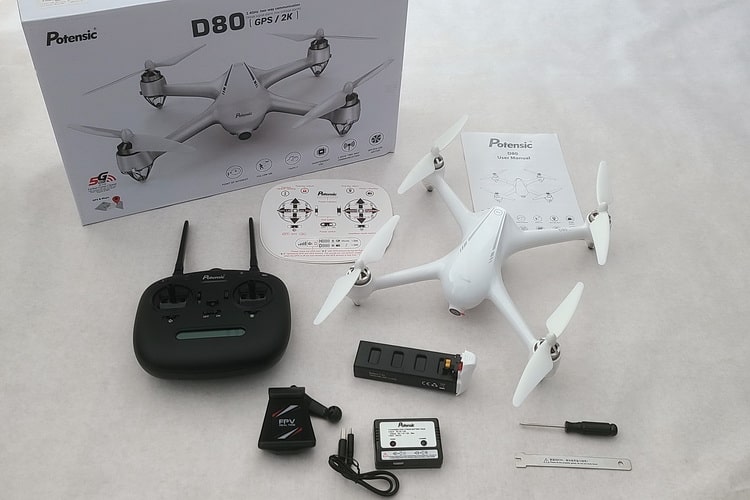
Packaging & Accessories
The packaging is pretty solid – the box measures 17.0 x 11.5 x 5.5 inches and weighs four pounds. It’s nicely and attractively designed; if you intend to give this as a gift, the recipient is sure to be excited just by seeing what’s shown on the packaging alone.
Inside the box you’ll find:
- 1 x Drone
- 1 x Controller
- 1 x Drone battery
- 1 x USB charging cable
- 1 x USB charger
- 1 x Cell phone holder
- 1 x Mini crosshead screwdriver
- 1 x Propeller replacement tool
- Instructions and Quick Start guide
NB: we tested the basic version, which did not come with a carry case or second battery. The version tested is no longer available on Amazon, but you can buy the upgraded version (with case and extra battery) here.
The drone and accessories are held very securely by a large, thick polystyrene molded block, which should keep everything protected against any knocks that might occur during transit.
The drone and smaller accessories (i.e., the battery, charger, instructions, etc.) are on the top, while the controller can be found on the bottom.
Assembly and Getting Started

If you’ve owned and/or used a drone before, there’s a Quick Start Guide to help get you up ‘n running as quickly as possible. This folding card includes a useful overview of the controller and is worth keeping nearby as you familiarize yourself with the drone and its capabilities.
In terms of the user manual, it’s fairly slim as there’s actually very little assembly required here; the drone doesn’t have propeller guards, and the rest of the manual predominantly serves as a guide to the functions of the controller and the features of the drone itself.
Controller batteries aren’t included and you’ll need to have four AA batteries on-hand, and you’ll also need to first charge the drone battery, which, unfortunately, does take a while – five hours, in fact. This could be a problem if you’ve got kids (or even older family members) who are keen to give the drone a test flight.
The battery is slotted into the back of the drone (make sure you remove the dust cover from the battery connectors first!) and the drone will then automatically power on. The lights located at the bottom of the propellers will then flash as the drone attempts to connect to the controller.
The drone then has to go through three more steps before you’re ready to go:
- Controller stick calibration: This involves pressing the one-key takeoff/landing button and then rotating the joysticks several times. It’s recommended that you do this before anything else, as you won’t be able to perform the calibration while the drone is powered on.
- Signal connection: If the controller is on, the drone will automatically attempt to acquire a signal with the controller. Once this is achieved, a signal strength indicator is shown on the controller’s LCD screen.
- Aircraft initialization detection: This happens once the signal between the drone and the controller is acquired. The lights on the drone will flash during the initialization, and then, after about 8 seconds, the front and rear lights alternately flash light green.
- Aircraft compass calibration: This needs to be done every time the battery is inserted and involves manually turning the drone in a full circle three times along two axes.
- Gyroscope calibration: This is easily done by pushing both joysticks toward the lower left and should be completed before flying for the first time and after a crash.
If you want to shoot video or capture images, the drone has a micro SD card slot on its right side, while if you want to use your smartphone to record images and video, you’ll need to download and install the Potensic-M2 app. Besides being able to store video and images, the app can also be used to fly the drone and to make use of some of the more advanced features, such as the way-point flight.
The included cellphone holder is attached to the controller and can be tilted and swiveled to get the best viewing angle. It’s easy to insert and remove and is able to hold and support the phone in its case, without the weight of the phone causing the holder to drop.
Quality and Durability

As the drone might be considered a mid-range model, it should come as no surprise that both the drone and the controller feel pretty solid and durable.
The controller has two antennae and an LCD screen that will show you the signal strength from the drone, the GPS signal strength, the number of satellites it’s currently using (a minimum of 7 is required), the drone’s height and distance, indicators to show if the Return to Home (RTH) and Headless Mode features are activated, indicators to show if the camera is taking a photo or shooting video, the “throttle mode” of the controller (ie, if the controller is in Mode 1 or 2 for left or right-handed control, respectively) and battery indicators for both the controller and the drone.
Both joysticks can be easily moved in a circular motion (as opposed to simply to the left/right or up/down) and there are two switches below the joystick: the left switch activates either GPS or Gesture Mode and the right switch activates Headless Mode.
There are four buttons along the top of the controller. From left to right, they are One-Key Takeoff/Landing, One-Key Unlock (used when first activating the drone before flight), One-Key Return and a button to capture images and video.
Curiously, there are several switches and buttons that do nothing and have no purpose; there are two switches between the joysticks and two buttons on the underside of the controller.
The drone itself is made of plastic but still has a decent weight to it. There are lights under each propeller, and each light is capped with a small rubber tip to help absorb the shock of landing on a hard surface.
There are no propeller guards and no replacement propellers either. The propellers are also thin and could be potentially easily damaged, so care must be taken not to fly the drone near any solid obstacles. For that reason, this drone is not one that should be flown indoors.
Unfortunately, the camera is fixed and cannot be moved; however, it’s capable of capturing images at 2K resolution (2048 x 1080) which is slightly better than blu-ray quality. There’s a micro SD card slot on the right side of the drone for onboard recordings.
If you’d like to capture images and video directly onto your smartphone, you’ll need to download and install the Potensic-M2 app and then connect to the drone’s wi-fi signal. The Wi-Fi network will appear on your phone as something like drone_D11A0D.
Performance and Ease of Use
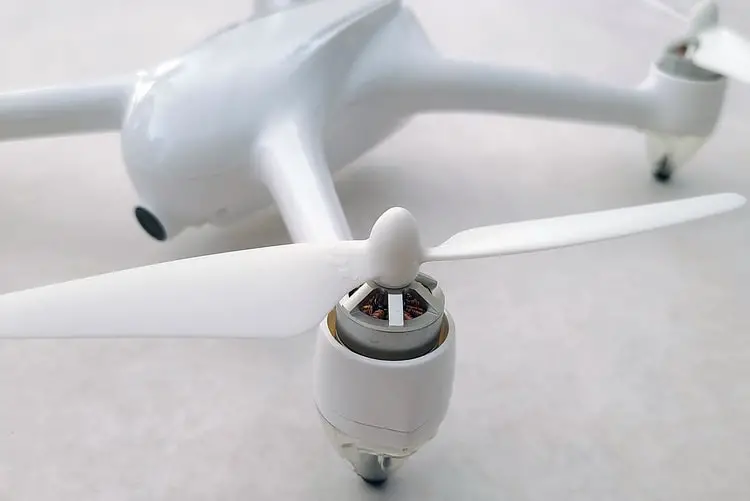
Generally speaking, the Potensic D80 (available here) performs admirably, with only a little drift (which is just as well because there doesn’t seem to be a way to adjust the trim.)
Features & Functions
The primary features and functions listed below can be easily performed via the controller with the push of a button and/or the movement of a joystick, with many of them also available via the app. It should be noted that there are no trims, flips, stunts or emergency stops with this drone.
- Lock/Unlock the Drone: This will start and stop the drone’s motors in readiness for flight.
- One Key Take-Off and Landing: This works well; the drone takes off to a height of about five feet and hovers without too much movement.
- Gesture Mode: While not explained in the instruction booklet, this allows operators to fly the drone, take pictures and shoot video using hand and arm gestures.
- GPS Mode: This integrates with Google Maps and shows you where your drone is, which could come in handy if you ever lose sight of it!
- Headless Mode: Great for beginners, this allows you to fly the drone in a basic forward/backward/left/right motion, making it easier for the operator to control the drone.
- Return to Home: As long as you’re connected to a minimum of 7 GPS satellites, this will return the drone to its starting location. There were always 12 available during the test.
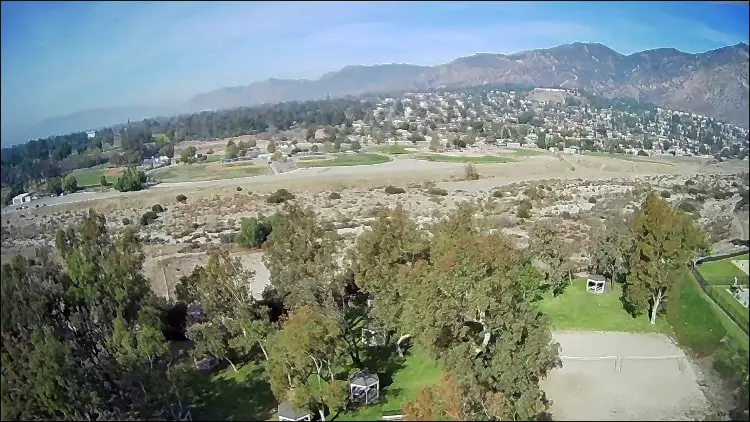
- Photos and Videos: This was tested by using the app to record video and images directly onto the cell phone. On a Samsung Android phone, neither the video or the images could be directly accessed without going through the app first, which was a little frustrating (you can share photos and videos by long-pressing the thumbnail.) Note that when images and video are recorded via wi-fi from the drone, the resolution and quality will be less than recording to an onboard micro SD card. Both the video and the photos are 1280 x 720 pixels when recorded by your phone, and while the actual video recording was relatively smooth, the image was occasionally a little blocky due to the strength of the wi-fi signal. Video is in MP4 format and images are JPEGs. (Other than rescaling, the image above has not been adjusted. It was taken at an altitude of approximately 22 meters, or 72 feet, with the video below being shot just a few minutes later.)
- Altitude Hold / Hover: Pretty good, as long as there’s no wind. The drone has enough weight to hold its position without too much effort. The drone was taken up to about 25 meters (82 feet) on a day with no wind and the drone barely drifted at all.
The following features and functions can be performed exclusively through the app:
- Point of Interest: Once you get the hang of flying the drone with the controller, you can highlight points of interest for the drone to visit on a map. The drone will then visit those points, giving you the opportunity to shoot video or take images.
- Follow Me: Like Gesture Mode, this may be more for advanced users, but when activated, the drone is capable of following you. This allows you to shoot video while on the move.
The screen has a map showing your location and the location of the drone and video from the drone. You’ll also find information on how far away the drone is (meters), its altitude (meters), its battery strength, the controller battery strength and the signal strength between the controller and the drone.
Target Audience
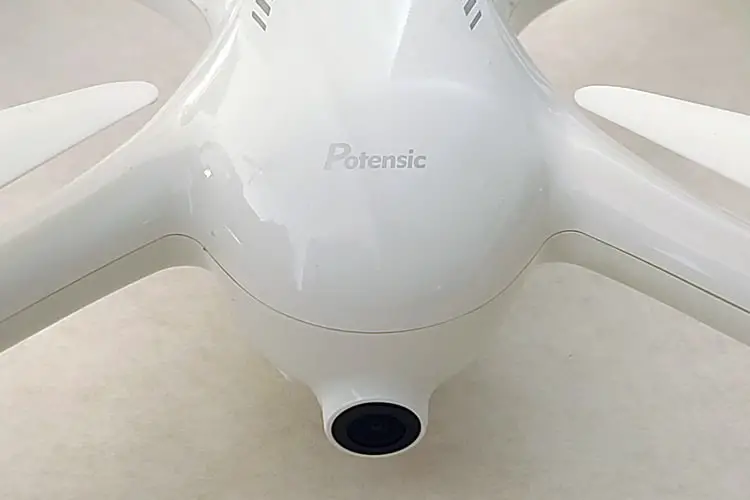
Although it could potentially be flown by a beginner, the D80 has really been designed for the intermediate adult pilot who’s looking for a good mid-range drone. It’s not a toy, and younger kids may have some difficulty controlling it, but if they’ve had previous experience flying more basic drones, they may be able to fly it under supervision.
Teenagers may need a little help at first, but once the basics are mastered there’s no reason why they shouldn’t be able to fly it on their own.
Specifications & Features
Specifications:
- Weight: 3.0 pounds
- Flight time per battery: 18 mins
- Number of batteries supplied: 1
- Battery charge time: 5 Hours
- Total flight time, out of the box: 18 mins
- Maximum range: 2600 feet (793 meters)
- Maximum height: 492 feet (150 meters)
- Video Transmission Range: 1000 feet (305 meters)
Features:
- Headless mode: Yes
- Manual return: Yes
- Smartphone FPV: Yes
- Auto Return: Yes
- One key take off / land: Yes
- Altitude hold: Yes
- Point of interest / custom mode: Yes
- Obstacle avoidance: No
- Stunts: No
- Colored LED Lights: Yes
- GPS Enabled: Yes
- Follow Me mode: Yes
What We Liked
- Handles very nicely
- Little drift
- Easy to control
- Good battery life
- High resolution images and video
What We Didn’t Like
- No trim
- Long battery charge time
- No propeller guards
- No replacement propellers
- Camera is fixed and cannot be moved
Final Verdict
While not the most inexpensive option, if you’re looking for a drone that’s easy to control, flies well and can shoot high-resolution video, then the Potensic D80 (available here) could be the one for you. It’s not the best choice for younger kids, but teenagers and adults shouldn’t have any problem making the most of its features and having a lot of fun in the process.
If you’re looking for more information about drones, we’ve created a series of guides to the different drones available. You can check out our overviews of the best kids drones with a camera and the best drones under $200 with a camera.
Additionally, we have a series of in-depth product reviews of specific drones, including our review of: the Holy Stone HS165 foldable drones, Eachine E520 Foldable Drones, Tomzon a31 flying pig mini drones, Snaptain s5c drones, Holy Stone hs340 mini drones, Holy Stone hs210 mini drones, Holy Stone HS110D Drones, Holy Stone hs120d drones, Holy Stone f181w drones, and our DEERC UFO mini drones. Each of these guides will walk you through the different features, instructions, pricing, and pros and cons for each drone to help you find the best one for you.

